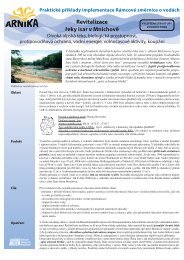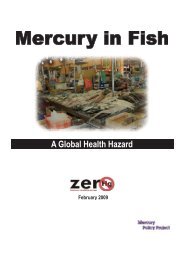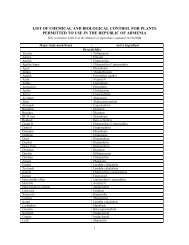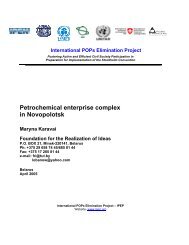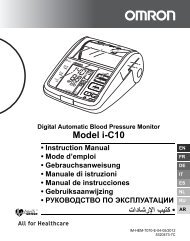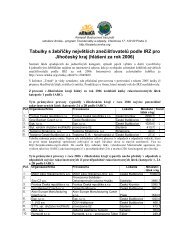Market analysis of some mercury-containing products and their ...
Market analysis of some mercury-containing products and their ...
Market analysis of some mercury-containing products and their ...
Create successful ePaper yourself
Turn your PDF publications into a flip-book with our unique Google optimized e-Paper software.
Mercury-<strong>containing</strong> fever thermometers have been made from relatively inexpensive<br />
glass tubes housing a small reservoir <strong>of</strong> <strong>mercury</strong>. This <strong>mercury</strong> exp<strong>and</strong>s at a known<br />
rate due to its physical relationship to temperature. Placing a scale on the glass tube<br />
allows for measurement <strong>of</strong> this expansion. Gas, liquid or other materials that come in<br />
sufficient contact with the glass impart <strong>their</strong> temperature on the <strong>mercury</strong> <strong>and</strong> allow for<br />
<strong>their</strong> temperature to be measured. Mercury contracts as the thermometer cools, but not<br />
necessarily uniformly. This <strong>of</strong>ten requires the user to shake the thermometer to re-pool<br />
the <strong>mercury</strong> into the lower end to get a proper reading. Environmental releases occur<br />
when a health care provider or home user break the thermometer <strong>and</strong>/or improperly<br />
dispose <strong>of</strong> the <strong>mercury</strong> contained within. Patients have been known to bite the thermometers<br />
to the point <strong>of</strong> breakage, but the most frequent releases occur when mish<strong>and</strong>ling<br />
the glass thermometer results in breakage.<br />
Sphygmomanometers measure blood pressure by using air pressure to displace a column<br />
<strong>of</strong> <strong>mercury</strong>. Once pressure is created by pumping up a tourniquet cuff wrapped<br />
around a patient’s extremity, the blood pressure is then read through a scale placed on<br />
the <strong>mercury</strong> column. Systolic <strong>and</strong> diastolic pressures are identified by a health pr<strong>of</strong>essional<br />
monitoring the patients pulse through a stethoscope as pressure in the tourniquet<br />
is released. Maintenance <strong>and</strong> calibration is required due to the loss <strong>of</strong> <strong>mercury</strong><br />
from the reservoir due to its connection to the ambient air. Environmental releases occur<br />
during maintenance <strong>and</strong> use since the device has direct exposure to open air. Larger<br />
amounts are released after breakage <strong>and</strong>/or disposal <strong>of</strong> these items. Aneroid (<strong>mercury</strong>-free)<br />
sphygmomanometers eliminate the <strong>mercury</strong> column <strong>and</strong> work directly with<br />
the air pressure to develop a reading. The pressure is then read through an analogue<br />
or digital readout.<br />
Dental amalgam is made <strong>of</strong> approximately 50% silver with small amounts <strong>of</strong> copper<br />
<strong>and</strong> tin mixed with 50% <strong>mercury</strong>. Amalgam is a durable, malleable material with antimicrobial<br />
properties. For over a century, these properties have lent themselves to use<br />
in dental restorations where tooth decay has only partially affected the tooth. Low levels<br />
<strong>of</strong> <strong>mercury</strong> are released throughout the lifetime <strong>of</strong> the amalgam exposing <strong>their</strong><br />
owner. Environmental <strong>mercury</strong> releases can occur both when amalgam materials are<br />
first placed <strong>and</strong>/or when they are removed. In addition, with increases in dental care<br />
<strong>and</strong> the growing use <strong>of</strong> cremation for dealing with loved ones after <strong>their</strong> death, large<br />
amounts <strong>of</strong> <strong>mercury</strong> from amalgam restorations now get volatilized directly to the at-<br />
6



